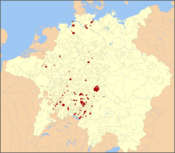Besançon
| Ville de Besançon | ||
|
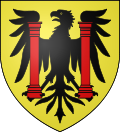 |
|
| City flag | City coat of arms | |
|
Motto: Utinam |
||
| Vauban Citadel of Besançon | ||
| Location | ||
|
||
| Time Zone | CET (GMT +1) | |
| Administration | ||
|---|---|---|
| Country | France | |
| Region | Franche-Comté | |
| Department | Doubs | |
| Intercommunality | Grand Besançon | |
| Mayor | Jean-Louis Fousseret (PS) (2008-2014) |
|
| City Statistics | ||
| Land area¹ | 65.05 km² | |
| Population² (2005 estimate) |
115,400 | |
| - Ranking | 29th in France | |
| - Density | 1,766/km² (2004) | |
| Urban Spread | ||
| Urban Area | 122 km² (1999) | |
| - Population | 134,376 (1999) | |
| Metro Area | 1,652 km² (1999) | |
| - Population | 222,381 (1999) | |
| 1 French Land Register data, which excludes lakes, ponds, glaciers > 1 km² (0.386 sq mi or 247 acres) and river estuaries. | ||
| 2 Population sans doubles comptes: residents of multiple communes (e.g., students and military personnel) only counted once. | ||
Besançon (pronounced [bəzɑ̃ˈsɔ̃] in French and Arpitan; German: Bisanz), is the capital and principal city of the Franche-Comté region in eastern France, with approximately 220,000 inhabitants in the metropolitan area in 1999. Located close to the border with Switzerland, it is the capital of the Doubs department.
Contents |
History
Ancient history
Sited with three sides within an oxbow of the Doubs River (a tributary of the Rhône River) with the fourth side closed by a mountain, in the first century BC through the modern era, the town held a significant military vantage point aided by the fact that to the immediate south, the Alps rise abruptly presenting a significant natural barrier. In historic times the town was first recorded in the journals of Julius Caesar as the largest town of the Sequani, a smaller Gaulic tribe, in his commentaries detailing his conquest of Gaul; he gave the name of the town as Vesontio (possibly Latinized) and mentions that it was surrounded by a wooden palisade.
Over the centuries, the name permutated to become Besantio, Besontion, Bisanz in Middle High German and gradually arrived at the modern French Besançon. The locals retain their ancient heritage referring to themselves as Bisontins (feminine: Bisontine).
Middle Ages
As part of the Holy Roman Empire since 1034, the city became the Archbishopric of Besançon, and was granted the status of Imperial Free City (an autonomous city-state under the Holy Roman Emperor) in 1184. In 1157, Emperor Frederick Barbarossa held an Imperial Diet (Reichstag) in Bisanz. There, Cardinal Orlando Bandinelli, (the future Pope Alexander III, then adviser of Pope Adrian IV), openly asserted before the Emperor that the Imperial dignity was a Papal beneficium (in the more general sense of favour, not the strict feudal sense of fief), which incurred the wrath of the German princes. He would have fallen on the spot under the battle-axe of his life-long foe, Otto of Wittelsbach, had Frederick not intervened; the Imperial Chancellor Rainald of Dassel then inaugurated a German policy which insisted upon the rights and the power of the German kings, the strengthening of the Church in the German Empire, the lordship of Italy and the humiliation of the Papacy. The Archbishops were elevated to Princes of the Holy Roman Empire in 1288. The close connection to the Empire is reflected by the city's coat of arms.
Renaissance
In the 15th century, Besançon came under the influence of the dukes of Burgundy. After the marriage of Mary of Burgundy to Maximilian I, Holy Roman Emperor, the city was in effect a Habsburg fief, which took it from Austrian to Spanish influence. In 1526 the city obtained the right to mint coins. It continued to strike coins until 1673. Nevertheless, all coins are in the name of Charles V, Holy Roman Emperor. The Spaniards originally built the main defense complex, "la Citadelle" from 1668, following a design by the French military architect Vauban. In 1674, French troops took the city and Vauban himself got to upgrade its fortifications, which took some 30 years. At the Treaty of Nijmegen the city was awarded to France.
Surrounding the central city are walls built in that era, and between the train station and the central city is a complex moat system through which traffic has been directed. All of these fortifications are built with Vauban's classic star points. Surrounding the city a large number of fortifications were built at the time of Vauban, including the Fort de Trois Châtels, Fort Chaudanne, Fort du Petit Chaudanne, Fort Griffon, Fort des Justices, Fort Beauregard and Fort de Brégille, but the crown jewel of these is la Citadelle.
Built upon a mountaintop, bounded by sheer cliffs on one side, the Doubs river on the others, and the Boucle or Shield, the city centre surrounded by the Doubs, giving it a fantastic defensive stance. Upon this hilltop, Vauban built the largest of his structures in the region. The Citadelle has a dual dry moat, with an outer and inner court. In the evenings, the Citadelle is illuminated and stands above the city as a landmark and a crowning achievement to Vauban's ingenuity.
Modern Europe
The Citadelle was used by the Nazis during World War II. Nevertheless, action was limited to a bombing of the railway complex in 1943 and four days of ultimately futile German resistance to U.S. attacks in 1944. Across the Doubs sits the Forts Brégille and Beauregard. The Brégille Heights were reached by a funicular built in 1913. It passed from private ownership during its usage to the SNCF until 1987 when it was finally shut down. To this day the tracks, stations and even roadsigns of the funicular remain in place.
Geography and climate
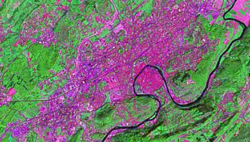
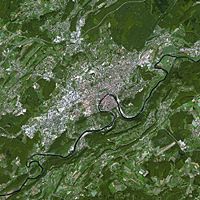
Geography
Besançon is located in the north-east quarter of France on the Doubs River. It is about 325 km (215 mi) east of the national capital of Paris, 100 km (60 mi) east of Dijon in Burgundy, 125 km (75 mi) northwest of Lausanne in Switzerland, and 100 km (60 mi) southwest of Belfort in Franche-Comté. It is located at the edge of the Jura Mountains.
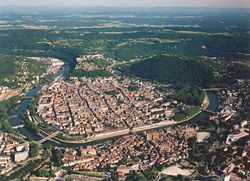
The city initially developed in a natural meander (or oxbow loop) of the Doubs River with a diameter of almost 1 km (3,281 ft). The flat inner loop has an elevation of about 250 m (820 ft) and is bounded to the south by a hill called Mont Saint-Étienne, which has a maximum height of 371 m (1,217ft). The city is surrounded by six other hills which range in elevation from 400 m (1,312 ft) to 500 m (1,640 ft).
The city center lies between seven hills, that used to be a particular efficient natural protection. The seven hills are: Bregille, Griffon, Planoise, Chaudanne, Montfaucon, Montboucon and the Citadel.
Climate
Besançon is under the influence of both an oceanic climate (notable precipitations in quantity as much as in frequency) and a continental climate with hard winters (snow, frost) and warm and dry summers. The year-round average is 10.2 °C (50 °F). The warmest month is July (18.9°C or 66°F) and the coldest is January (1.6°C or 35°F). Besançon receives about 1108 mm (44 inches) of precipitation per year. The wettest month is May (111.4 mm or 4.4 in); the driest is July (80.5 mm or 3.2 in). The highest temperature ever, recorded on 31 July 1983, was 38.8 °C (101.8 °F), and the lowest was a −20.7 °C (−5.3 °F) reached on 1 January 1985.
| Month | Jan | Feb | Mar | Apr | May | Jun | Jul | Aug | Sep | Oct | Nov | Dec | Year |
|---|---|---|---|---|---|---|---|---|---|---|---|---|---|
| Avg temperature °C (°F) | 1.6 (35) | 3.3 (38) | 6.1 (43) | 9.4 (49) | 13.3 (56) | 16.5 (62) | 18.9 (66) | 18.3 (65) | 15.7 (60) | 11.3 (52) | 5.6 (42) | 2.1 (36) | 10.2 (50) |
| Avg rainfall mm (in) | 91.1 (3.6) | 81.8 (3.2) | 83.5 (3.3) | 91.6 (3.6) | 111.4 (4.4) | 100.1 (3.9) | 80.5 (3.2) | 86.9 (3.4) | 93.2 (3.7) | 85.8 (3.4) | 103.7 (4.1) | 99.0 (3.9) | 1108 (43.6) |
| Source: Météo France | |||||||||||||
Demographics
As of the French Census of 1999, the population of the City of Besançon was 117,733, lower than the historical peak of 120,315 in 1975. As of February 2004 estimates, the population of the city proper was 114,900. The Besançon agglomeration or urban area (unité urbaine) covers 122 km², 11 municipalities (communes) and has a population of 134,376. The metropolitan area (aire urbaine) covers 1,652 km², 234 municipalities (communes) and has 222,381 inhabitants. It's the 37th of France. It increased by 11.4% between 1990 and 1999.
| 1800 | 1836 | 1841 | 1861 | 1876 | 1896 | 1911 | 1921 | 1936 | |
|---|---|---|---|---|---|---|---|---|---|
| City of Besançon | 28 436 | 29 718 | 36 461 | 46 786 | 54 404 | 57 556 | 57 978 | 55 652 | 65 022 |
| Urbanized Area | |||||||||
| 1946 | 1954 | 1962 | 1968 | 1975 | 1982 | 1990 | 1999 | 2005 | |
| City of Besançon | 63 508 | 73 445 | 95 642 | 113 220 | 120 315 | 113 283 | 113 828 | 117 733 | 115 400 |
| Urbanized Area | 116 200 | 126 349 | 120 715 | 122 623 | 134 376 |
Government and Politics
Besançon is the capital of the Franche-Comté région of France, a région including the four départements of Doubs, Haute-Saône, Jura and Territoire de Belfort. As such, it is the seat of the Franche-Comté regional council, and the regional préfecture (government offices).
Mayor of the City of Besançon is Jean-Louis Fousseret.
Economy
The city is famous for its microtechnology and watch industries. It is host of the biannual Micronora trade fair, one of Europe's major events in the field of microtechnologies. The city has a little-known speciality, automatic ticketing machines for car parking, airports, date stamping etc.
The watch industry, for which Besançon remains the French capital, endured a major crisis in the 1970s when the advent of far-eastern quartz watches knocked out the traditional watch industry in the space of just a few years. This industrial crisis was epitomised by the famous "Lip" affair, by the name of one of Besançon's most prestigious brands of watches. Refusing to be beaten, the workers of Lip took over their factory and set it up as a worker's cooperative. The event branded Besançon as a city of the radical left, and though it produced a lot of notoriety and sympathy for the workers, it did little to help revive the watch industry, with the cooperative going out of business after a short period. The city took a long time to recover from the collapse of the watch industry and its other major industry of the industrial age, artificial textiles.
Since the 1980s, Besançon's watch industry has clawed its way back on the basis of its historic reputation and quartz watches, establishing itself in a number of niche markets including customized watches, high quality watches, and fashion articles. Since the 1990s, the town has developed a reputation as one of France's leading centres technology in all fields, including telecommunications and biotechnology.
Education
Besançon is the seat of the Université de Franche-Comté. As of 2006, there were approximately 20,000 students enrolled at the university, including around 3,000 foreign students. The city is also home of the École Nationale Supérieure de Mécanique et des Microtechniques (ENSMM), a technological school with a strong reputation in the fields of microtechnology and mechanics and the worldwide famous Centre for Applied Linguistics which teaches ten languages to non-native speakers (French, Arabic, Chinese, English, German, Italian, Japanese, Portuguese, Russian, Spanish) and any other known language on request and which welcomes more than 3000 students every year from all over the world.
Culture
Sites of interest
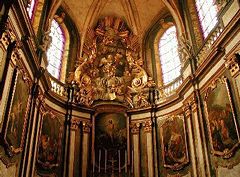
The city has one of the most beautiful historic centres of any major town in France. The old town, "la Boucle", is enclosed in a broad horse-shoe of the river Doubs, which is blocked off at the neck by Vauban's imposing Citadelle. The historic centre presents a remarkable ensemble of classic stone buildings, some dating back to the Middle Ages. Among the most visited historic monuments are:
- the 16th century Palais Granvelle, built by Cardinal Granvelle, chancellor to the Habsburg emperor Charles V [Palais:[1],[2]
- Vauban's citadel and remarkable riverside frontage
- the St. Jean cathedral, dating largely from the 12th century [3]
- several Roman remains, notably the Porte Noire, a triumphal arch and the Square Castan.
The citadel, the city walls and Fort Griffon were added to the list of UNESCO World Heritage Sites in 2008, as part of the "Fortifications of Vauban" group.
Besançon also has one of the finest city art galleries in France outside Paris. The Musée des Beaux Arts has a collection built up since 1694, and expanded over time by a remarkable series of bequests. The building itself was totally rebuilt in the 1960s by the architect Miquel, a pupil of Le Corbusier, its interior taking the form of a gently rising concrete walkway that takes visitors up from classical antiquity to the modern age. Among its treasures are a fine collection of classical antiquities and ancient Egyptian artefacts, as well as a very rich collection of paintings including works by Bellini, Bronzino, Tintoretto, Titian, Rubens, Jordaens, Ruysdael, Cranach, Zurbarán, Goya, Philippe de Champaigne, Fragonard, Boucher, David, Ingres, Géricault, Courbet, Constable, Bonnard, Matisse, Picasso and many others. Perhaps the most remarkable of the city's masterpieces is the massive Virgin and saints altarpiece in the St. Jean cathedral, by the Italian Renaissance painter Fra Bartolomeo.
Museums, aquariums, and zoos
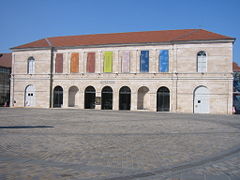
- Museum of Fine Arts and Archeology
- Museum of Time
- Museum of French Resistance and Deportation in the Vauban's Citadel of Besançon.
- Museum of Franche-Comté traditions
- Museum of Natural history: zoo, aquarium, insectarium, noctarium, climatology
Gardens, parks, and squares
- Jardin botanique de Besançon
- Parc Micaud
- Parc de la Gare d'Eau
- Parc de la Citadelle
- Promenade Granvelle
- Promenade Chamars
- Place de la Révolution
- Place du Huit Septembre
Performing arts centers
- Opéra Théâtre: construit par Ledoux de 1778 à 1784
- Grand Kursaal
- Nouveau Théâtre - Centre Dramatique National
- Cirque Plume
- Théâtre Bacchus
- Théâtre de la Bouloie
- Théâtre de l'Espace
Annual cultural events and fairs
Several major events occur annually in Besançon. One of the best-known is the Besançon Franche-Comté Music Festival, taking place in September, one of the oldest and most prestigious Classical music festivals. Besançon hosts other music festivals such has the Musiques de Rues Festival (street music) in October, the Franch Country Festival (country music) in August, the Jazz en Franche-Comté Festival in June or the Herbe en Zik Festival (french rock and variety) in May.
Sports
The major sports in Besançon are handball and basketball. The city's soccer club, called Besançon Racing Club plays in the French fourth division.
Besançon also had a fairly successful hockey team in the early 2000s. The Séquanes, named after an ancient gallic tribe, reached the French Cup final in 2002 (which the city hosted) and briefly played in the country's top league, then called Super 16.
However the Séquanes' free spending policy soon backfired. The team folded in the middle of the 2002/03 season due to financial problems. Today, senior hockey subsists in Besançon in the form of a low level amateur team.
| Club | Sport | League | Stadium |
|---|---|---|---|
| Besançon Racing Club | Football | Championnat de France Amateurs | Stade Léo Lagrange |
| Entente Sportive Bisontine Masculin | Handball | Nationale 1 | Gymnase des Montboucons |
| Entente Sportive Bisontine Feminin | Handball | Division 1 (women's) | Palais des Sports |
| Besançon Basket Comté Doubs | Basketball | Pro A | Palais des Sports |
Transport
Besançon is situated at the crossing of two major lines of communication, the NE-SW route, following the valley of the river Doubs, and linking Germany and North Europe with Lyon and southwest Europe, and the N-S route linking northern France and the Netherlands with Switzerland. A key staging post on the Strasbourg-Lyon (Germany-Spain) route, it also has direct high-speed train (TGV) links with Paris, Charles de Gaulle International Airport, and Lille. Unusually for a town of its size, it does not have a commercial airport, though two international airports, EuroAirport Basel-Mulhouse-Freiburg and Lyon Saint-Exupéry International Airport, can be reached in about 2 hours.
Births
Besançon was the birthplace of:
- Claude Goudimel (1510-1572) - Musician, Teacher of Palestrina. Composer of the music for Protestant hymns
- Antoine Perrenot de Granvelle (1517-1586) - Cardinal, statesman and humanist. Counsellor of Charles V, Viceroy of Naples
- Jean Mairet (1604-1686) - Dramatist
- Charles Fourier (1772-1837) - Inventor of socialist "phalansteries" (vast communal buildings surrounded by a highly cultivated agricultural area)
- Charles Nodier (1780-1844) - Writer. Leader of the Romantic movement
- Jean Claude Eugène Péclet (1793-1857) - physicist, gave his name to the Péclet number
- Victor Hugo (1802-1885) - Writer and poet
- Pierre-Joseph Proudhon (1809-1865)- Journalist (Le Peuple) and author of world-renowned socialist theories
- Hilaire de Chardonnet (1838-1924) - Inventor of artificial silk
- Louis-Jean Résal (1854-1920) - Engineer who built the Pont Mirabeau and the Pont Alexandre III in Paris
- Auguste and Louis Lumière, (1862-1954) and (1864-1948) - Inventors of cinematography
- Tristan Bernard (1866-1947) - Journalist and Humorist
- Jean de Gribaldy (1922-1987) - Professional racing cyclist and directeur sportif
- Raymond Blanc (1949- ) - Chef
- Morrade Hakkar (1972- ) - Boxer
- Justice (French band) (Gaspard Augé) (1979- ) - Electro band performer
- Fabrice Barbier (1955) photographer, radio animator, journalist
Popular culture
- Julius Caesar, in his account Commentarii de Bello Gallico gives a description of the antique city of Besançon, named Vesontio (first book, section 38):
[1.38] When he had proceeded three days' journey, word was brought to him that Ariovistus was hastening with all his forces to seize on Vesontio, which is the largest town of the Sequani, and had advanced three days' journey from its territories. Caesar thought that he ought to take the greatest precautions lest this should happen, for there was in that town a most ample supply of every thing which was serviceable for war; and so fortified was it by the nature of the ground, as to afford a great facility for protracting the war, inasmuch as the river Doubs almost surrounds the whole town, as though it were traced round it with a pair of compasses. A mountain of great height shuts in the remaining space, which is not more than 600 feet (180 m), where the river leaves a gap, in such a manner that the roots of that mountain extend to the river's bank on either side. A wall thrown around it makes a citadel of this [mountain], and connects it with the town.
- In Stendhal's novel Le rouge et le noir, Julien Sorel, the main character, studies for a while at the catholic seminary from Besançon (first book, chapters 24 to 30):
Eventually he saw the white walls beyond the distant mountain; it was the citadel of Besancon. "What a difference", he said, sighing, "if I could come into this fine city as a sub-lieutenant of one of these regiments of the post." Besancon is not only one of the prettiest cities in France, but it abounds in brave and intelligent men. Julien, however, was only a little peasant, without any means of approaching distinguished personages.
- In the poem This century were two years old (Les Feuilles d'automne), Victor Hugo evokes his birth in Besançon:
This century was two years old. Rome was replacing Sparta;
Already Napoleon was emerging from under Bonaparte.
And already the First Consul's tight mask
Had been split in several places by the Emperor's brow.
It was then that in Besancon, that old Spanish town,
Cast like a seed into the flying wind,
A child was born of mixed blood -- Breton and Lorraine --
Pallid, blind and mute,...
That child, whom Life was scratching from its book,
And who had not another day to live,
Was me.
- Besançon is where the Touché! series, an Australian series of books that teaches people French, is set. The series is about an Australian boy called Nick, who moves to a street in Besançon called rue Cézanne after his parents are separated. He befriends a French girl called Marianne, who introduces him to other residents of rue Cézanne, such as Ahmed, Annick, François Petitpain, Émile Mesquin, Monsieur Fric, Madame Boulin and Mademoiselle Moh. The first two books of the series take place in Besançon, whilst in the third, Nick visits his uncle in New Caledonia. In the fourth, Nick stays in Quebec, Canada. After the fourth book, Nick returns to Besançon.
- Julian Barnes' novel A History of the World in 10½ Chapters features as chapter 3: "Wars of Religion"--a fictional manuscript reportedly from the Archives Municipales de Besançon.
Balzac's novel Albert Savaron takes place in Besançon.
Colonel Sainte-Hermine, the fictional hero of Alexandre Dumas' The Last Cavalier, is a native of Besançon.
Twin cities
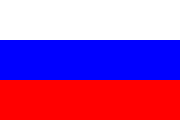 Tver (Russia)
Tver (Russia) Freiburg im Breisgau (Germany)
Freiburg im Breisgau (Germany)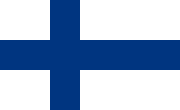 Kuopio (Finland)
Kuopio (Finland) Huddersfield - Kirklees (England)
Huddersfield - Kirklees (England) Bielsko-Biala (Poland)
Bielsko-Biala (Poland) Neuchâtel (Switzerland)
Neuchâtel (Switzerland)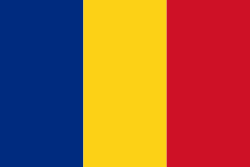 Bistriţa (Romania)
Bistriţa (Romania) Pavia (Italy)
Pavia (Italy) Hadera (Israel)
Hadera (Israel) Douroula (Burkina Faso)
Douroula (Burkina Faso)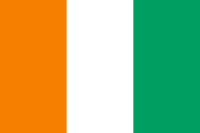 Man (Côte d'Ivoire)
Man (Côte d'Ivoire)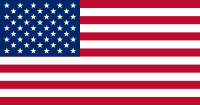 Charlottesville - Virginia (United States)
Charlottesville - Virginia (United States)
Trivia
As well as being famed as one of France's finest "villes d'art" (art cities), Besançon is the seat of one of France's older universities, of France's National School of Mechanics and Micromechanics, and one of the best known French language schools in France, the CLA. It is also reputed to be France's most environmentally-friendly city, with a public transport network that has often been cited as a model. On account of the topography, the historic city centre lies at the edge of the modern city, and hiking tracks lead straight from the centre and up into the surrounding hills. The city council has been in the hands of the Socialists and parties of the left since the Second World War. Queen Beatrix of the Netherlands is also Dame of Besançon.
The Christmas carol "Berger, Secoue Ton Sommiel Profond", known in English as "Shepherds, Shake Off Your Drowsy Sleep" originated in Besançon in the seventeenth century.
See also
- Archbishopric of Besançon
Notes
- ↑ Sources: INSEE; Cassini
External links
- City Council Website (in French)
- Besançon - All Events in Besançon, Real City Guide (in French)
- Besac.com: Online Média for Besançon: Events, Classifieds, Online Shops (in French)
- Unofficial Funicular Website (bilingual, French/English)
- Official Funicular Website (French only)
- Webpage about the Fortifications
- Besançon City Guide (in French)
- Besançon's Weblog (in French)
- Besançon Hymn
- Besançon and around area directory search engine (in French)
|
||||||||||||||||||||||||
|
||||||||||||||||||||
|
|||||||||||
|
||||||||
|
|||||


